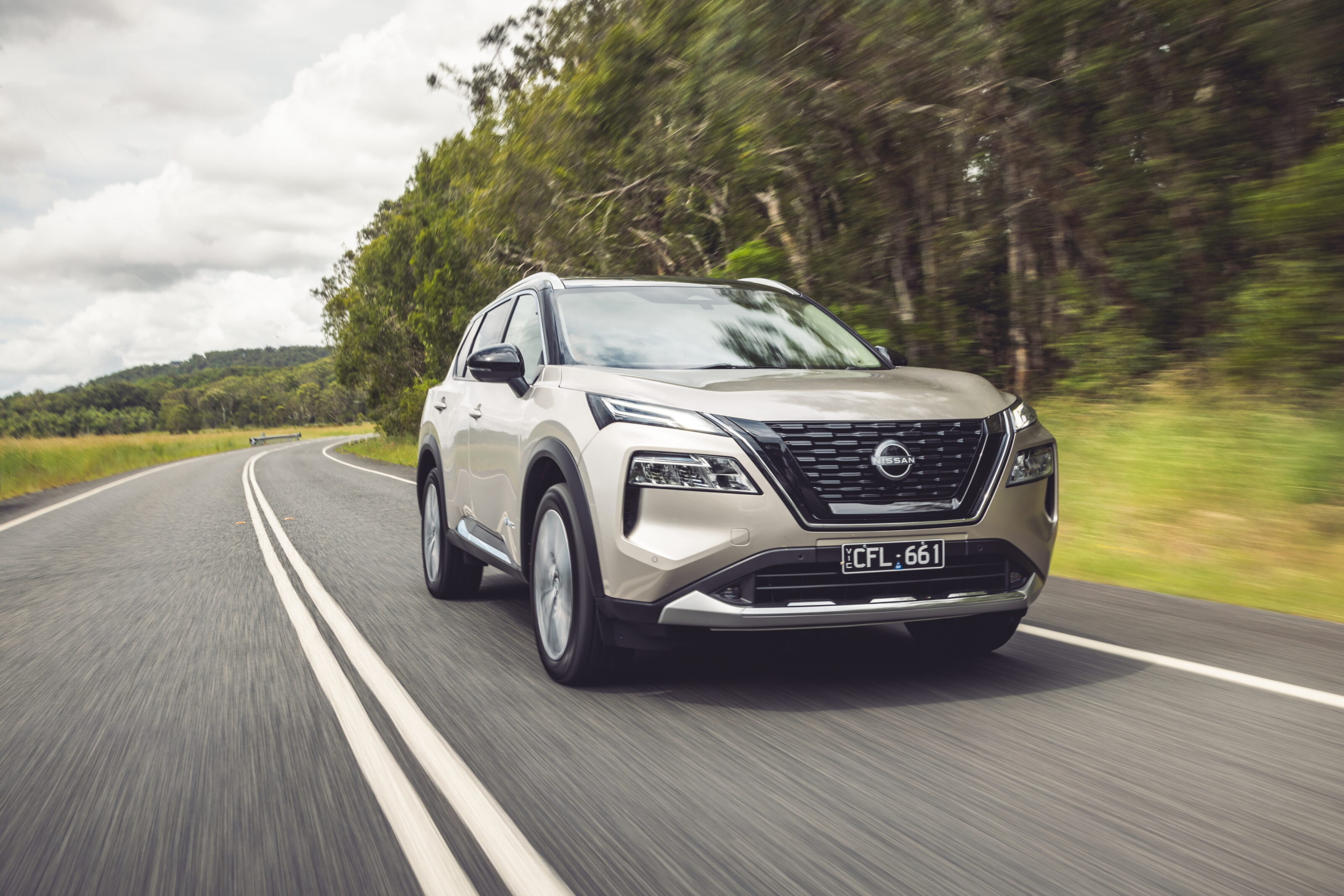
Score breakdown
Things we like
- Quiet, EV-like drive
- Cosseting ride
- Practical storage solutions
- Rolling acceleration
Not so much
- Weight up 250kg
- Expensive servicing
- On-paper efficiency
The 2023 Nissan X-Trail E-Power AWD has two electric motors, a lithium-ion battery under the front seats, a variable compression ratio turbo-petrol engine and marketing material labelling it as ‘the missing link’ between internal combustion engines (ICE) and electric vehicles.
However, with an ADR 81/02 combined fuel consumption rating of 6.1L/100km, the X-Trail E-Power is only 1.5L/100km better than the equivalent ICE X-Trail and falls 1.3L/100km short of the petrol-electric efficiency benchmark that is the Toyota RAV4 hybrid AWD.
If it’s economy numbers you care about above all else, the RAV4 is the pick. But it would be remiss and ignorant to write the X-Trail E-Power off on numbers alone.
The hybrid E-Power builds on the fantastic (and recent comparison-winning) X-Trail recipe; a thoughtfully packaged, beautiful-riding, spacious medium SUV that easily slips into daily life like few other rivals.
It’s a handsome car, too, with the E-Power black V-Motion grille adding menace to the X-Trail’s attractive proportions. Finished in Gun metallic or Diamond black, the up-spec Ti and Ti-L really look the part.
JUMP AHEAD
- How much is it, and what do you get?
- How do rivals compare on value?
- Interior comfort, space and storage
- What is it like to drive?
- How is it on fuel?
- How safe is it?
- Warranty and running costs
- VERDICT
- Specifications
How much is it, and what do you get?
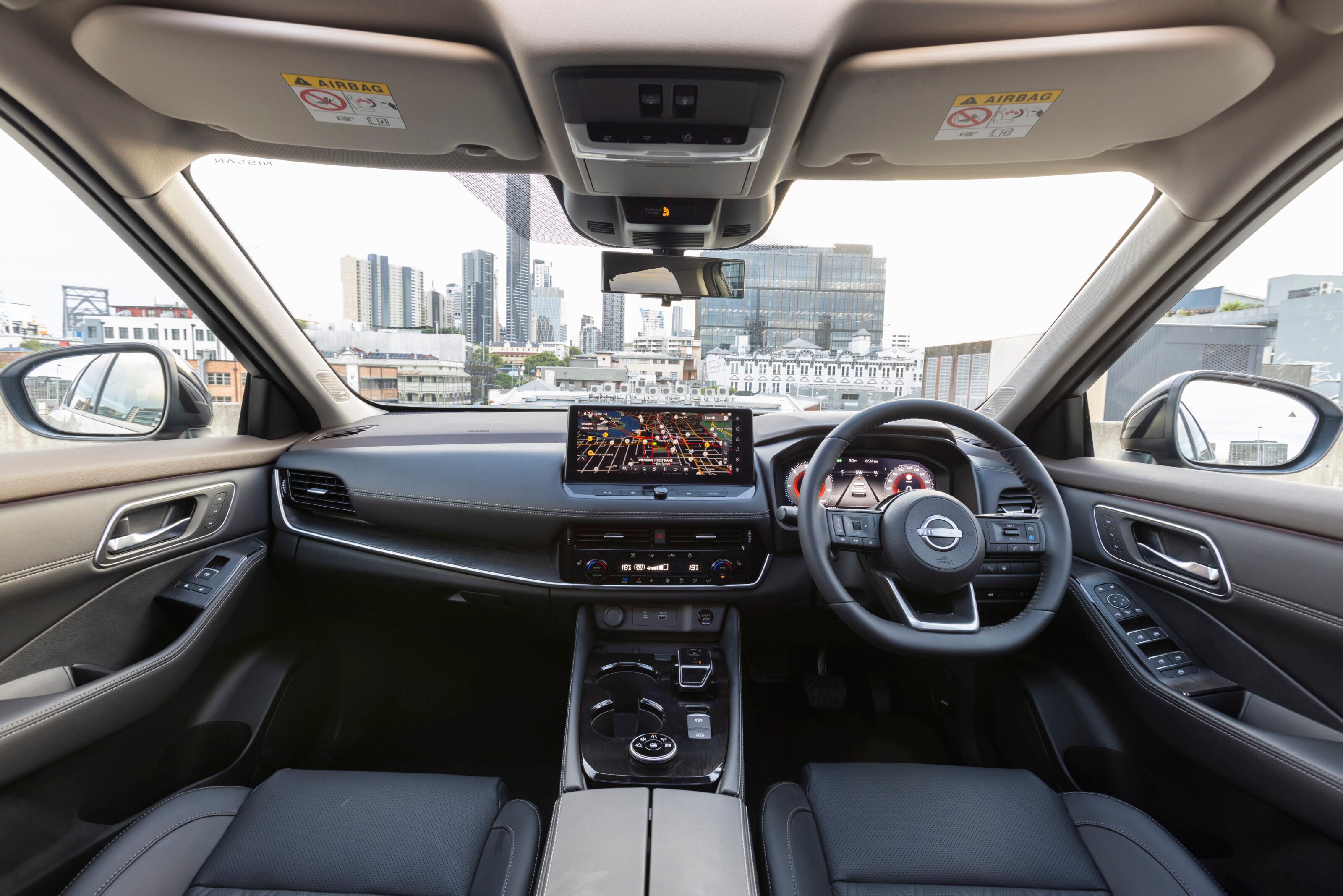
Unlike RAV4, the 2023 Nissan X-Trail E-Power is available only in ritzy top-grade Ti and Ti-L trims featuring an electric all-wheel-drive system that Nissan calls E-4orce.
A starting price of $54,190 before on-road costs pitches the hybrids $4200 higher than their 2.5-litre ICE X-Trail equivalents.
The Ti is a typically well-equipped medium SUV and frankly could have stood as the range-topper if Nissan wanted. It’s all you need, with features such as:
| Nissan X-Trail E-Power Ti features | |
|---|---|
| 10.6-inch head-up display | Heated front seats |
| 12-way power driver and passenger seat | Leather upholstery |
| 12.3-inch digital driveru2019s display | LED taillights |
| 12.3-inch touchscreen | Matrix LED headlights |
| 15W wireless charging pad | Panoramic sunroof |
| 19-inch alloy wheels | Power tailgate |
| 4x USB ports | Privacy glass |
| Active noise cancelling | Tri-zone climate control |
| Ambient lighting | Wired Android Auto |
| Divide-and-hide luggage system | Wireless Apple CarPlay |
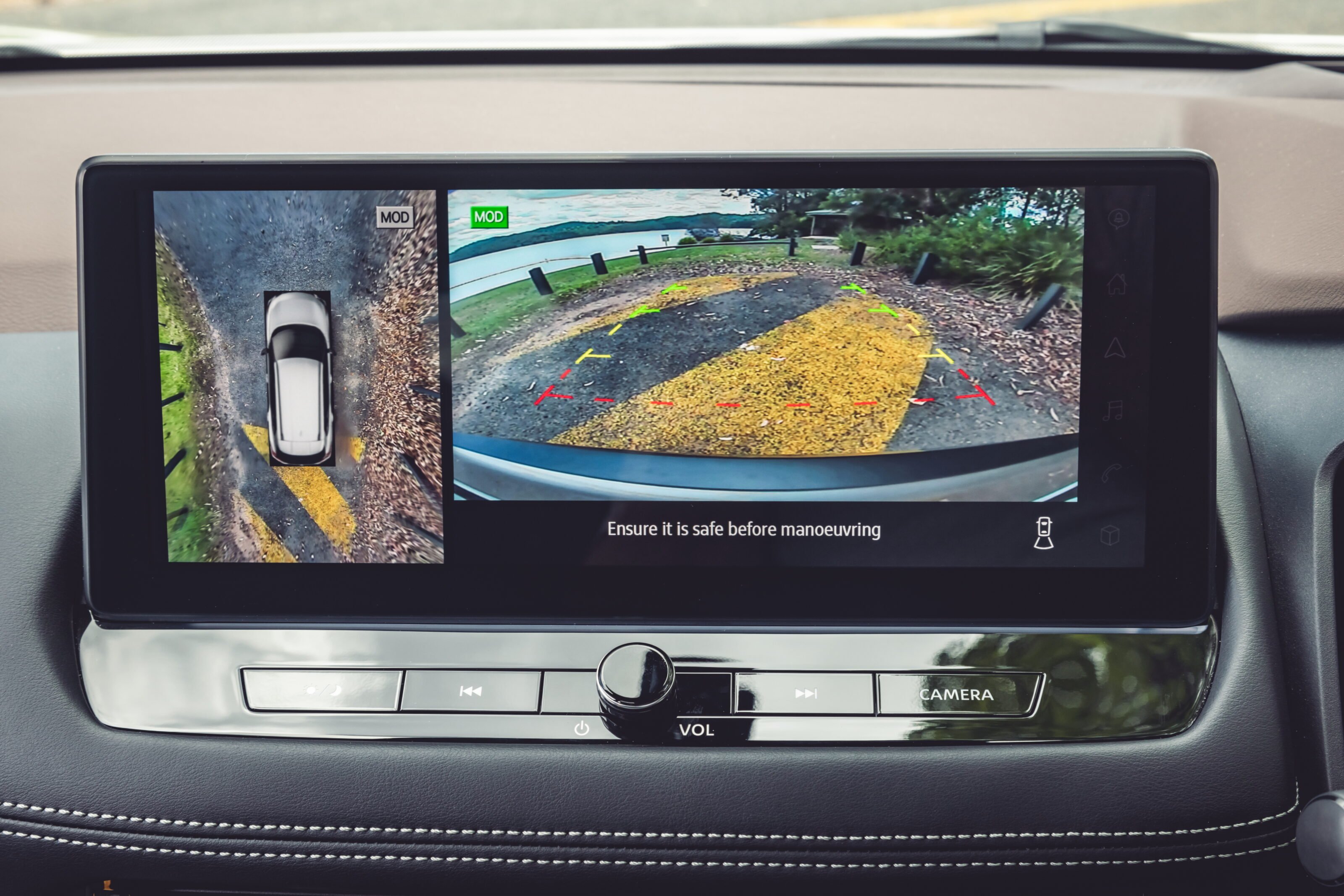
That said, the $57,190 before on-road costs Ti-L (L presumably standing for ‘luxe’) is a lush place to be with the tasteful choice of Ferrari-like tan quilted Nappa leather upholstery, should you wish to indulge.
Other features for the $3K premium include:
| Nissan X-Trail E-Power Ti-L additional features | |
|---|---|
| 20-inch alloy wheels | Extra ambient lighting |
| Auto-tilt mirrors in reverse | Quilted Nappa leather upholstery |
| Heated rear seats | Rear sun shades |
| Heated steering wheel | Remote engine start |
| Kick-to-open power tailgate | Two-position front-seat memory |
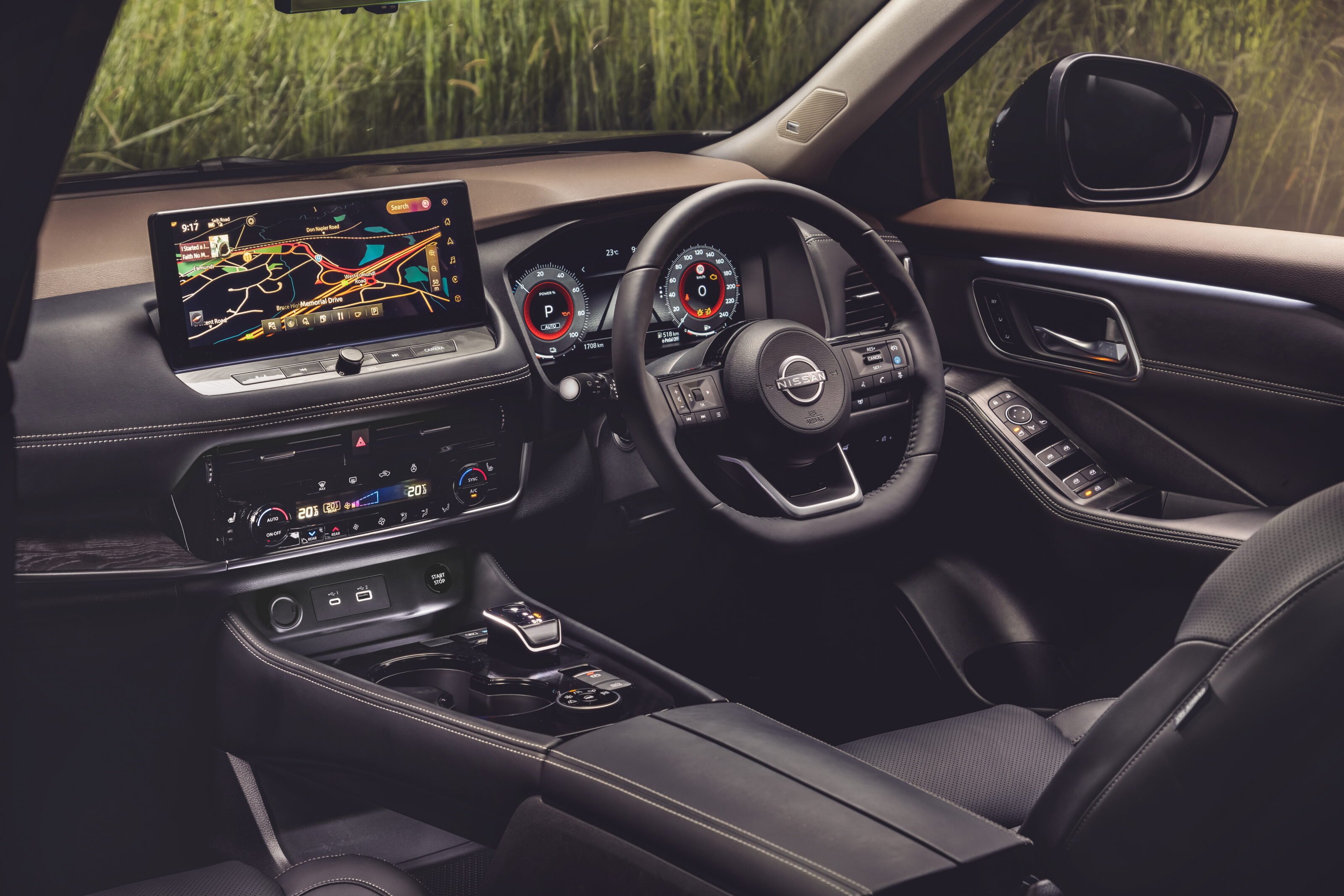
How do rivals compare on value?
Despite Toyota’s hybrid RAV4 dominating sales share (the petrol-electric variant makes up 70 per cent of Australian RAV sales), there isn’t a huge number of non-plug-in hybrid rivals.
Nissan doesn’t anticipate E-Power variants to displace those with an atmo four-cylinder for sales in the first year but neither does it rule out stronger sales for the electrified powertrain.
There’s no hybrid Kia Sportage or Hyundai Tucson, despite calls for them, and the Mitsubishi Outlander plug-in hybrid is a different (and $12,800 more expensive) kettle of fish.
So really, the X-Trail E-Power only has to worry about direct drivetrain competition from Toyota’s RAV4 hybrid AWD (Cruiser $52,7900; Edge $56,650 before on-road costs) and the GWM Haval H6 Ultra hybrid ($45,990 drive-away). There’s also the Tesla Model Y, which at $68,900 before on-road costs is dearer, but is a fully electric SUV with more grunt and newer tech.
Interior comfort, space and storage
If you caught Dan Gardner’s review on the new X-Trail range, you’ll be aware of what a step forward the latest ‘T33’ is in terms of cabin ambience. It may not immediately jump out on a spec sheet, but the X-Trail grows on you over time in a way the Kia Sportage and Toyota RAV4 don’t.
Pride of place in the X-Trail is a 12.3-inch touchscreen. It’s easy to reach, with shortcut buttons and a straightforward user interface. The physical climate controls sit below with a sensible layout.
The dash is appointed in brown soft-touch plastic on top, with leatherette cushions on the fascia. In the ritzy Ti-L, buyers are able to choose tasteful quilted tan Nappa leather upholstery to lift the ambience – a great distinguisher for the range-topping model over a Ti.
Comfy seats, too, with 12-way power adjust for driver and passenger including lumbar, three-stage heating. Two-position memory for both front seats is standard on Ti-L.
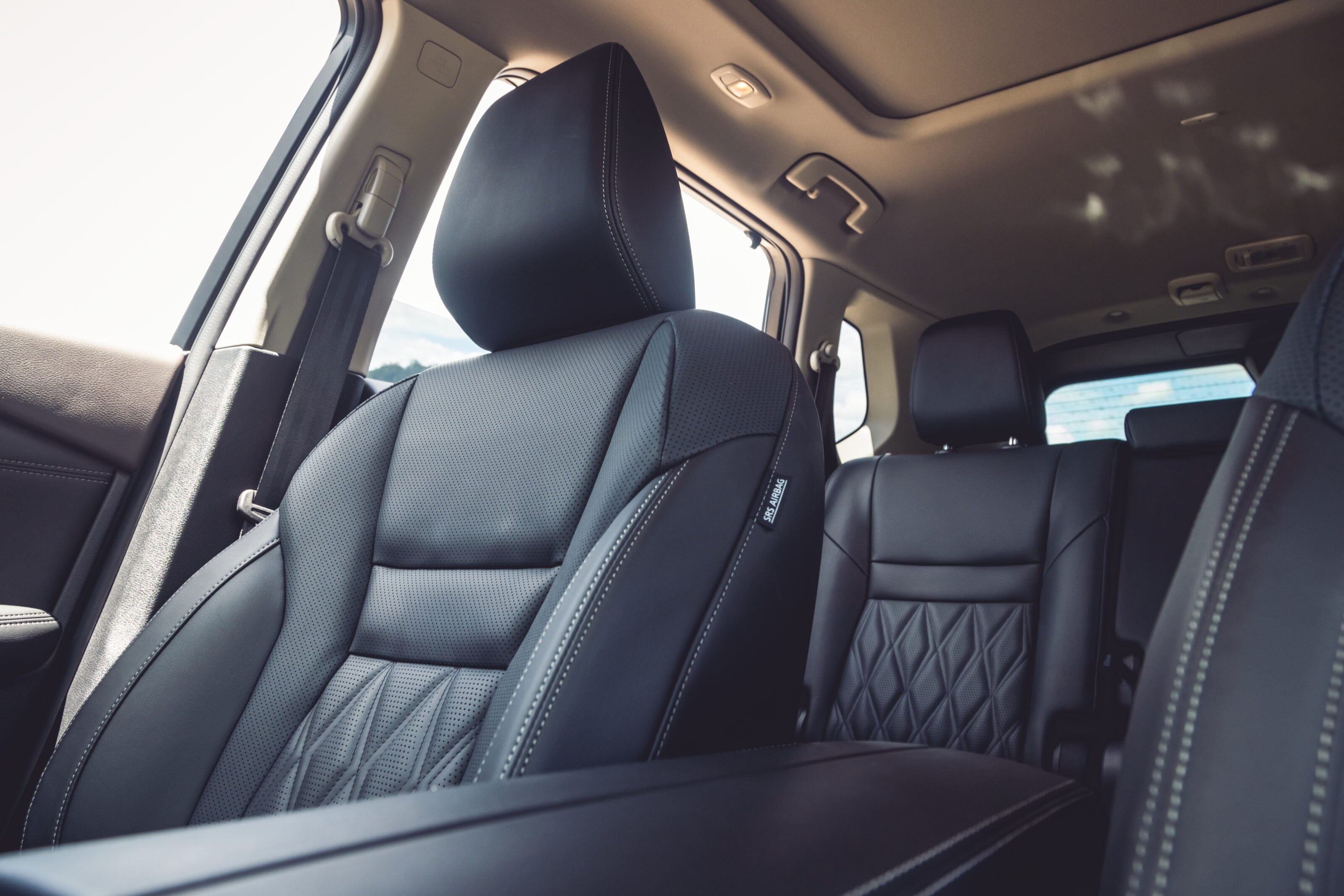
Two cup holders feature in the textured centre console, located above a rubberised storage tray that is perfect for small bags or notepads. Good-sized door bins and a deep central cubby with a butterfly-opening lid finish the X-Trail practicalities.
Wireless charging is standard, complemented by USB-C, USB-A and 12-volt sockets to charge devices from the front seat.
The X-Trail continues to impress in the back with an elevated bench that gives a stadium view over front occupants. It’s easily wide enough for three across the bench, and those over 180cm tall will be plenty comfortable.
A third zone for the climate can be controlled by rear passengers or those in front, while the Ti-L gets heated outboard rear seats. Only the X-Trail’s armrest is a letdown. It’s more of a ski port with hard plastic cup holders that annoy the elbow.

Door hinges may not sound exciting, but the X-Trail’s cast metal items are completely different to related Outlander’s stamped hinges, enabling the doors to open out to 85º for a big aperture. It’s so easy to feed baby seats and kids in – you can even parkour leap through the X-Trail, should you wish.
Nissan was keen to point out that the E-Power X-Trail doesn’t lose any cabin space compared to petrol-only versions.
That’s true for occupants – with the battery slipped seamlessly under the front seats – but the AWD system’s rear motor does rob 10 litres of VDA cargo capacity. And although 575L is still plenty, there’s no spare tyre fitted to AWD E-Power models.
A divide-and-hide configurable floor is included on Ti and Ti-L, perfect for separating shopping from other bags. Nissan claims 16 different configurations for boot storage are possible. The second row also folds completely flat, with a power tailgate as standard, making it easy to pop the trunk and load bulky items.
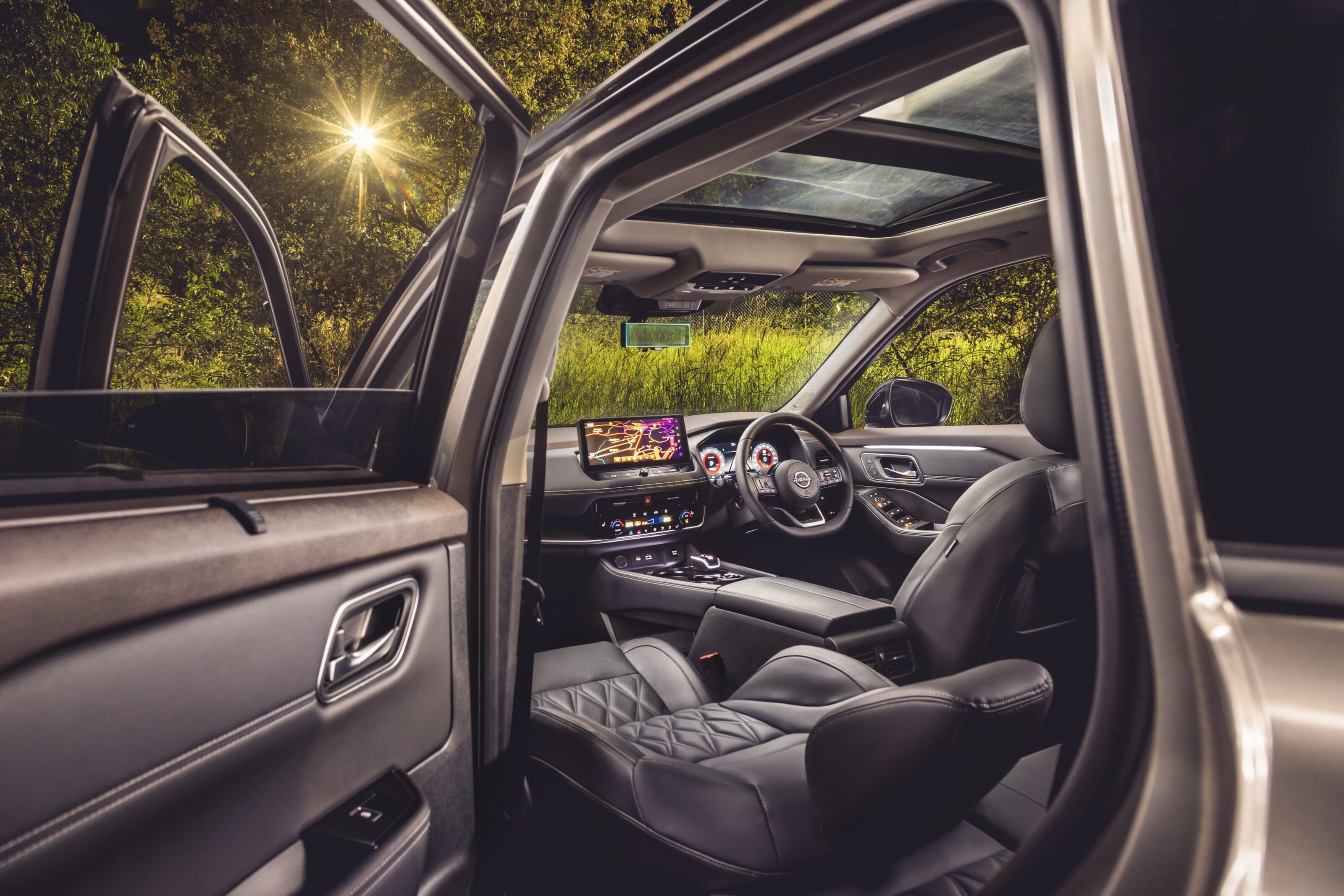
What is it like to drive?
The basics
| Nissan X-Trail E-Power hybrid | |
|---|---|
| Model | X-Trail E-Power AWD |
| Combustion engine | 1.5L turbo-petrol 3-cyl, DOHC, VCR |
| Electric motors (F | R) | 150kW/330Nm | 100kW/195Nm |
| System power | 157kW |
| 0-100km/h | 7.0 seconds |
| Gearbox | single-speed |
| Body | steel, 5-door, 5-seat medium SUV |
| Fuel/tank | 95 RON / 55 litres |
| Economy | 6.1L/100km (ADR 81/02) |
| Boot space | 575L |
The E-Power is bamboozling on paper, but the way it drives couldn’t be simpler.
One 150kW/330Nm electric motor mounted at the front and a second 100kW/195Nm motor on the rear axle combine for a 157kW peak power figure, and a claimed 0-100km/h sprint of 7.0 seconds.
The E-Power’s wheels are turned exclusively by the electric motors, with a 106kW/250Nm 1.5-litre turbo-petrol three-cylinder combustion engine with variable compression ratio providing top-up energy for the 2.1kWh lithium-ion battery.
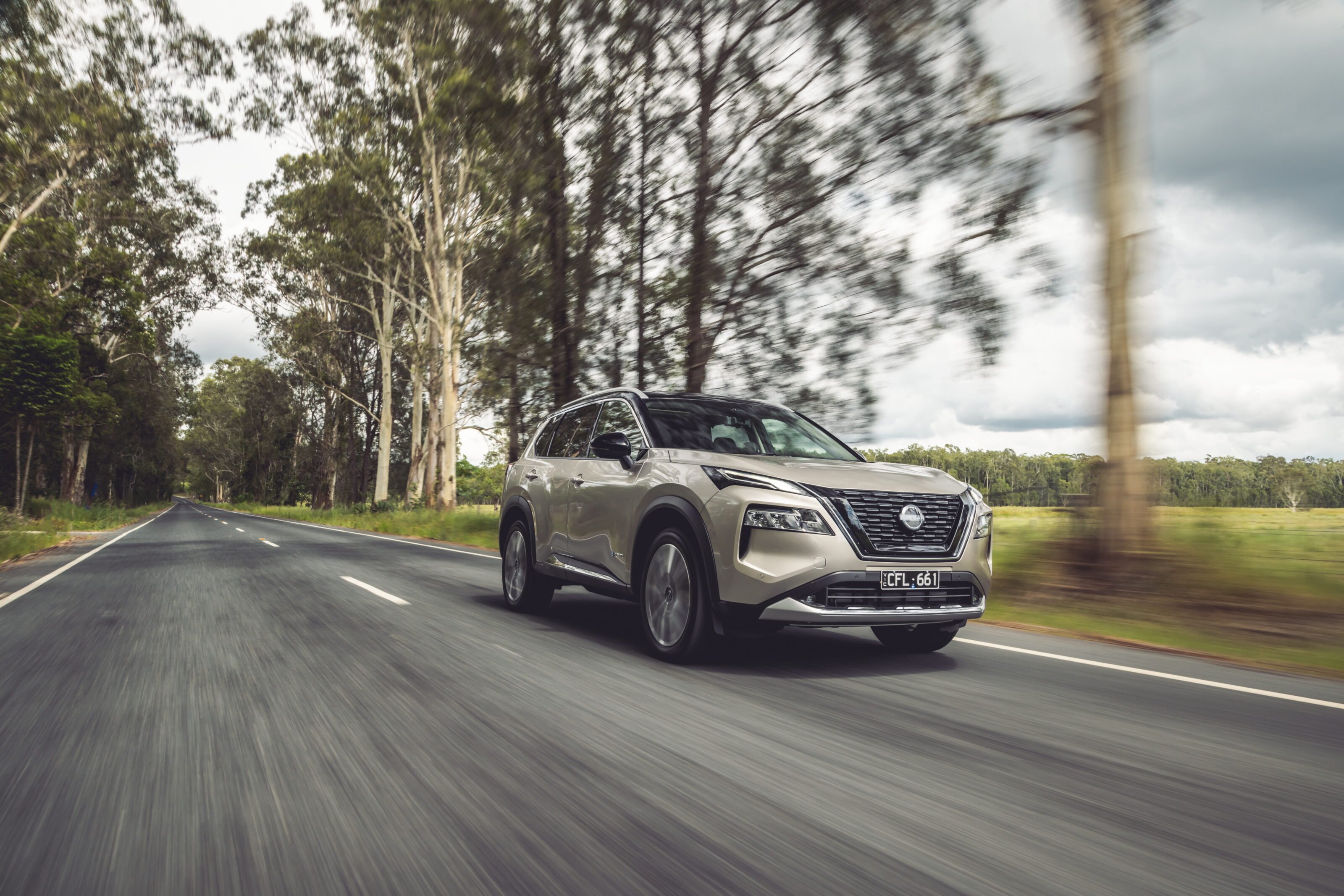
Under full throttle, the X-Trail E-Power’s combustion engine does provide grunt to the electric motors via the inverter (bypassing the battery) but there’s no driveshaft connecting the petrol engine to the wheels.
Complexity continues in the combustion engine itself. The pistons rotate on individual cams that allow the compression ratio to vary between 8:1 for maximum power to 14:1 to hit peak efficiency. Toyota’s answer to this is running its hybrid engines in the Atkinson cycle, but to quieten the powertrain and minimise the ‘rubber band’ effect, Nissan chose the variable compression route.
There’s no tacho, but we’re told the engine rotates below 2400rpm when at less than 50 per cent throttle under 80km/h.
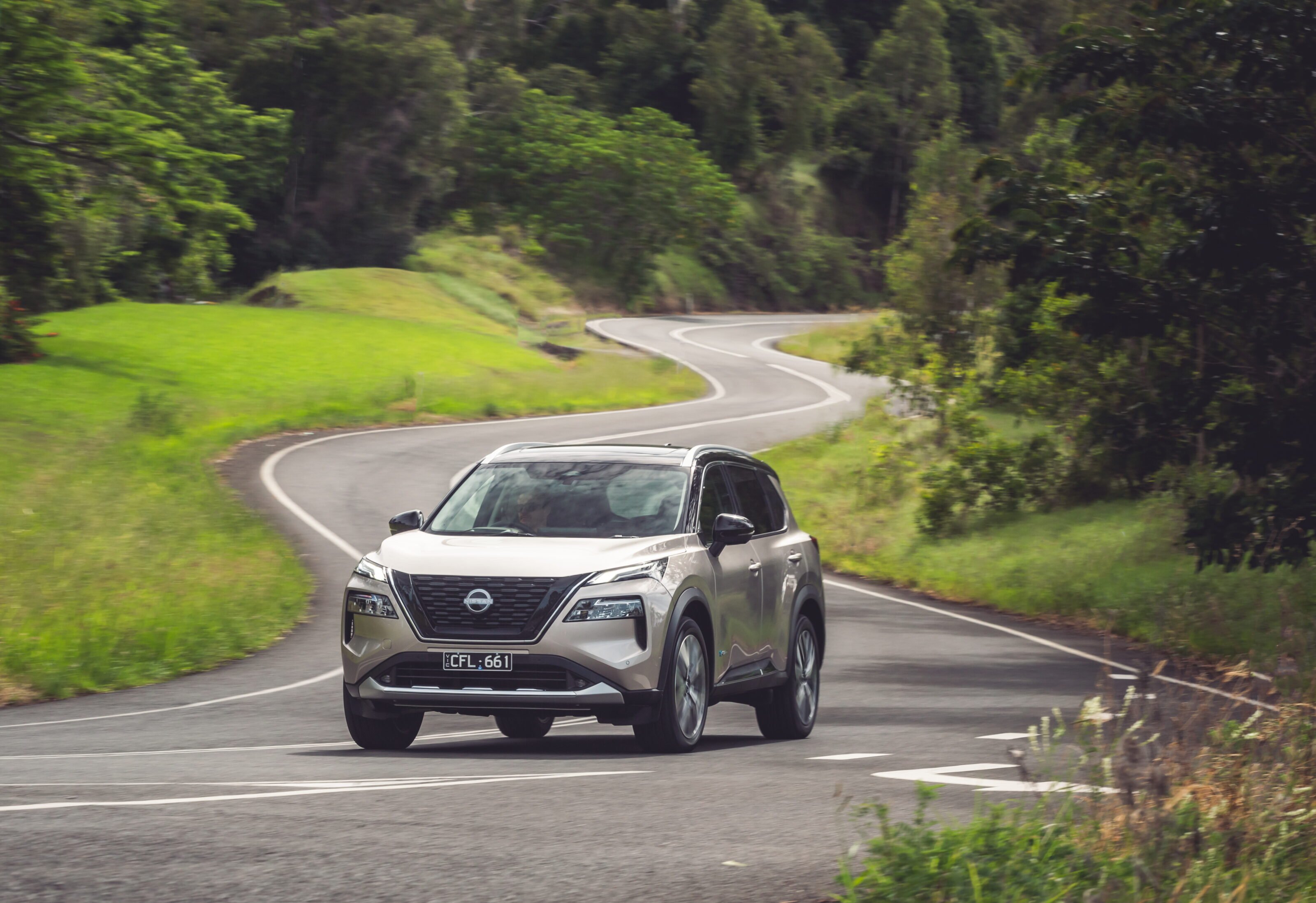
Nissan’s solution is nerdy, complex and a little mind-bending on paper – but in the real world, it translates to a refined, responsive and relaxing drive.
Only occasionally do you hear the three-pot thrum (standard active noise cancellation helps minimise that further), otherwise, it’s EV sailing.
Hitting the EV Mode button, we managed around 4km on battery power alone. There’s also an E-Pedal mode (developed first on the Leaf) which uses regenerative braking to slow the car (preferencing the rear motor to minimise forward pitch under deceleration) to 7km/h, at which point the driver has to step in and apply the left-hand pedal.
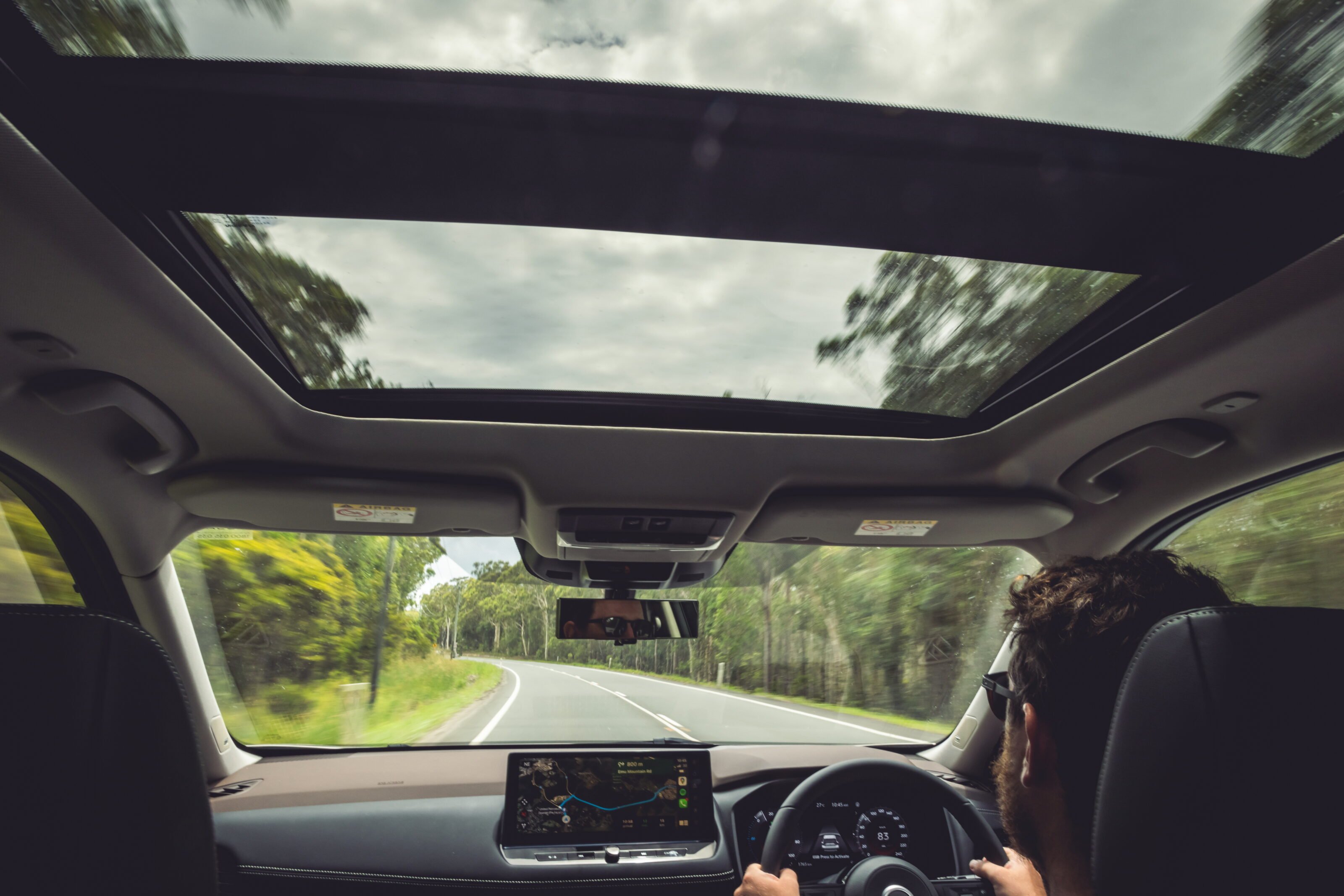
When using E-Pedal mode, the brake pedal disappears down into the foot well, which is disconcerting at first but intentional. The X-Trail E-Power primes the brake lines with pressure, for a more natural pedal location when the time comes to stop. Clever.
Away from the X-Trail’s typical urban stomping ground, it continues to impress. The electric motors give the E-Power serious alacrity when punching from 60-100km/h, with noise, vibration and harshness remaining well suppressed.
Select Sport mode and the steering weights up, the throttle sharpens and a little extra regen braking simulates engine braking. Tipping the X-Trail through tight and technical roads around Brisbane’s hinterland reveals a secure and neutral chassis.
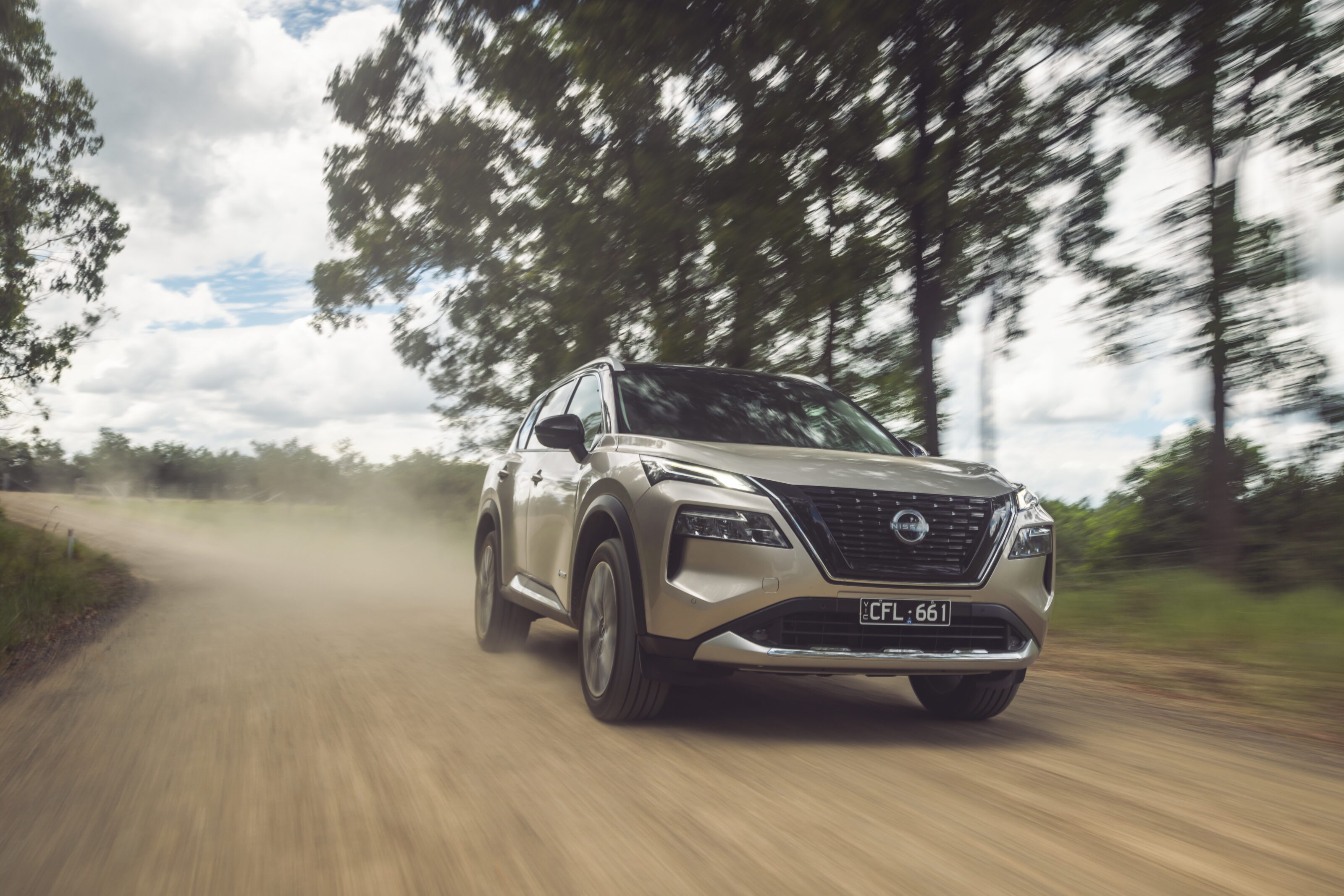
The E-Power has more advanced torque-vectoring by brake, which helps keep the medium SUV on the driver’s intended line.
Combined with the AWD system’s ability to move torque around at 1/10,000th of a second, this gives the X-Trail E-Power great traction on dirt, too. Switching the drive selector into Off-Road directs more torque rearward for improved grip.
Grip is good from the 235/50R19 Dunlops on the Ti, and only improves with the 255/45R20 Michelin Primacy 4 rubber of the Ti-L. The larger wheels introduce whisker more fidget from small bumps, but it’s nowhere near as much as a Mitsubishi Outlander fitted with 20s.
The X-Trail’s ride is generally excellent; compliant when you want and supportive when you need.
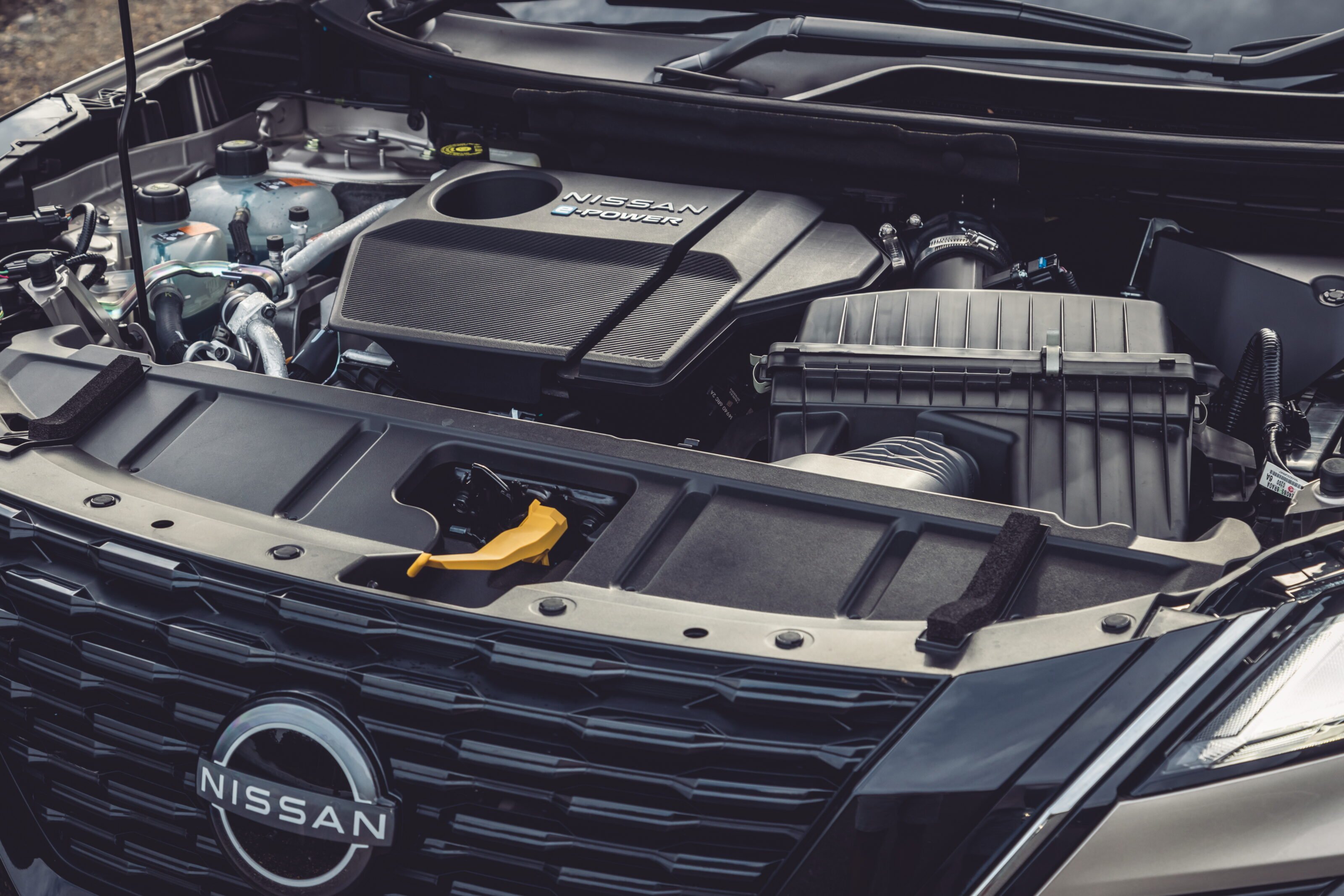
How much fuel does it use?
Nissan quotes an ADR combined fuel consumption figure for the X-Trail E-Power AWD of 6.1L/100km, and 6.5L/100km on the urban cycle. 95 RON premium unleaded is recommended, but the E-Power will take 91 RON in a pinch.
The Toyota RAV4 Hybrid AWD is the winner on paper, with 4.8L/100km combined and 5.0L/100km in the urban cycle.
In the real world, though, the Nissan provided very promising results. Over 300km of fast open-road driving the E-Power’s trip computer read an agreeable 6.5L/100km.
A supplementary 45-minute urban test around Brisbane’s suburbs saw the X-Trail E-Power’s fuel consumption fall to 5.5L/100km. Granted, that was maximising the use of EV mode and the E-Pedal program but we kept up with traffic and had the air-con set to 18º and fan speed at four.
How safe is it?
The 2023 Nissan X-Trail E-Power was rated five-stars in ANCAP safety testing based on partner model testing with Qashqai.

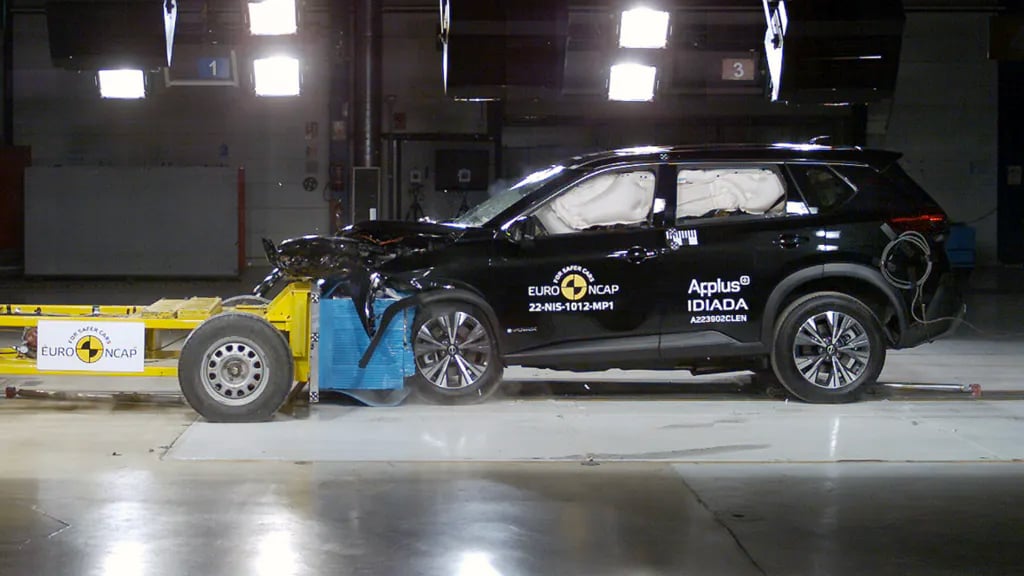
It was subjected to two additional crash tests, and separate data was taken on its active safety systems for its rating
We deemed the driver assistance features mature in their tuning, with much-improved lane-trace assist from before, and good adaptive cruise control programming. The aids have various levels of efficacy adjustable using the 12.3-inch digital driver’s display.
| 2023 Nissan X-Trail E-Power safety features | |
|---|---|
| 360-degree camera system | Driver awareness monitor |
| 7 airbags | Lane-trace assist |
| Adaptive cruise control with stop & go | Rear cross-traffic alert |
| Blind-spot monitoring with intervention | Rear occupant monitoring |
| Digital rear-view mirror | Reverse AEB |
| Front auto emergency braking with pedestrian/cyclist/junction detection | |
Warranty and running costs
The Nissan X-Trail is covered by a five-year, unlimited-kilometre warranty in Australia, with six years of capped-price servicing.
Maintenance is due more regularly than rivals such as the Toyota RAV4 and Haval H6 HEV, with the X-Trail E-Power requiring a service every 12 months or 10,000km.
The servicing is expensive, too, costing $2353 for five years or 50,000km. For the average Australian who travels around 13,000km annually, by the fifth year of ownership you’ll have covered 65,000km, meaning the sixth service is due. It’s a major one, and costly at $698.
It results in a five-year average ownership cost of $3051, compared to $1650 for a Haval H6 hybrid or more than twice that of a RAV4 hybrid ($1300).
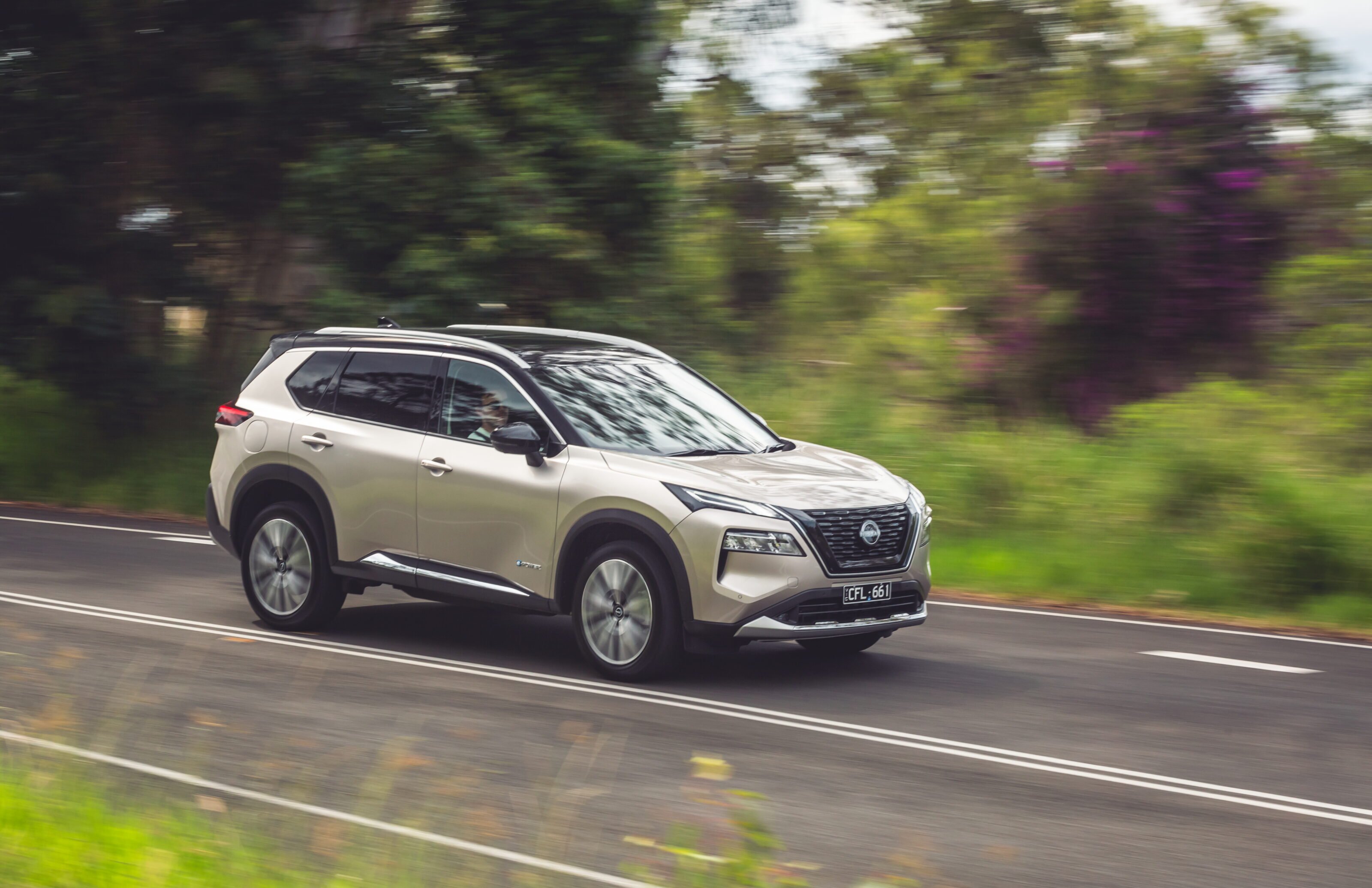
VERDICT
The Nissan X-Trail hybrid has its flaws; servicing is expensive, the ANCAP rating is a little misty, and on-paper fuel consumption not exactly jaw-dropping.
But as a medium SUV to drive? It’s easily one of the best out there.
The ride quality, chassis confidence and well-integrated safety aids are the start, and the practical, thoughtful cabin icing on the cake.
For those willing to alter their driving attitude and maximise electric-only driving with E-Pedal, 5-5.5L/100km urban fuel efficiency should be possible.
The Ti is equipped handsomely, but a Ti-L with tan interior is worth the extra for visual interest alone. And if you’re just happy paying $4200 for a much more modern and refined powertrain, then the E-Power is easy to recommend.
Nissan X-Trail E-Power specifications
| Nissan X-Trail E-Power | Ti | Ti-L |
|---|---|---|
| Price | $54,190 + on-road costs | $57,190 + on-road costs |
| Drivetrain | ||
| Engine | 3cyl, 1.5-litre, DOHC, VCR, turbo-petrol, direct-injected | |
| Electric motor (F|R) | 150kW/330NM | 100kW/195Nm | |
| Layout | front engine, twin electric motor, AWD | |
| Power | 157kW | |
| Torque | not specified | |
| Traansmission | single-speed | |
| 0-100km/h | 7.0 seconds (claimed) | |
| Chassis | ||
| Body | steel, 5-door, 5-seat medium SUV | |
| L/W/H/Wu2013B | 4680/2065/1725/2705mm | |
| Track (F/R) | 1575/1580mm | |
| Weight | 1903kg | 1911kg |
| Boot | 575L | |
| Fuel/tank | 95 RON / 55 litres | |
| Economy (combined ADR81/02) | 6.1L/100km | |
| Suspension | Front: struts, coil springs, anti-roll bar. Rear: multi-link, coil springs, anti-roll bar | |
| Steering | electric rack-and-pinion | |
| Front brakes | disc | |
| Rear brakes | disc | |
| Tyres | Dunlop Grandtrek | Michelin Primacy 4 |
| Tyre size | 235/55R19 | 255/45R20 |
| Safety | ||
| ANCAP rating | five stars | |
Score breakdown
Things we like
- Quiet, EV-like drive
- Cosseting ride
- Practical storage solutions
- Rolling acceleration
Not so much
- Weight up 250kg
- Expensive servicing
- On-paper efficiency
We recommend
-
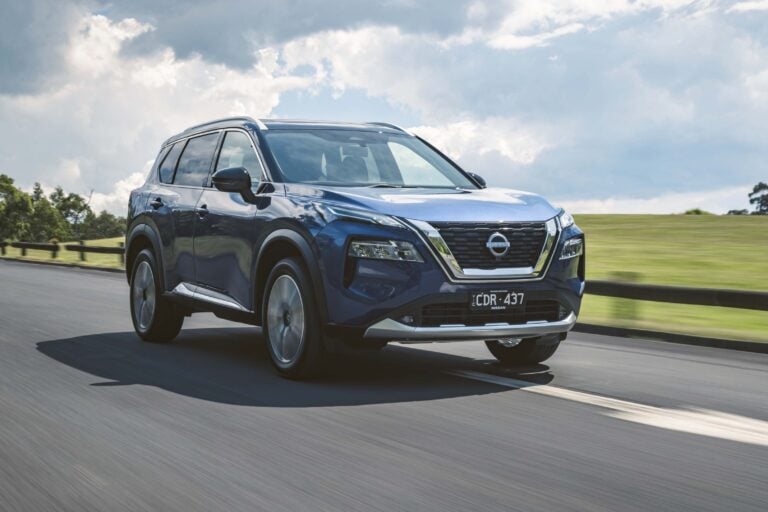 News
News2023 Nissan X-Trail pricing and features
The all-new X-Trail has arrived with four model grades, a host of safety features, and available hybrid power
-
 Reviews
Reviews2023 Nissan X-Trail review: First Australian drive
Nissan’s high-end X-Trail costs more, but the cash has been well spent
-
 News
NewsNew car calendar 2026: All the new cars coming to Australia next year
Here’s the WhichCar by Wheels guide to all the new cars that will launch in Australia in 2026. Check back in regularly for updates...




